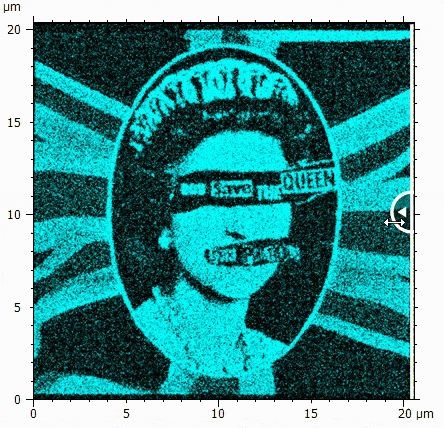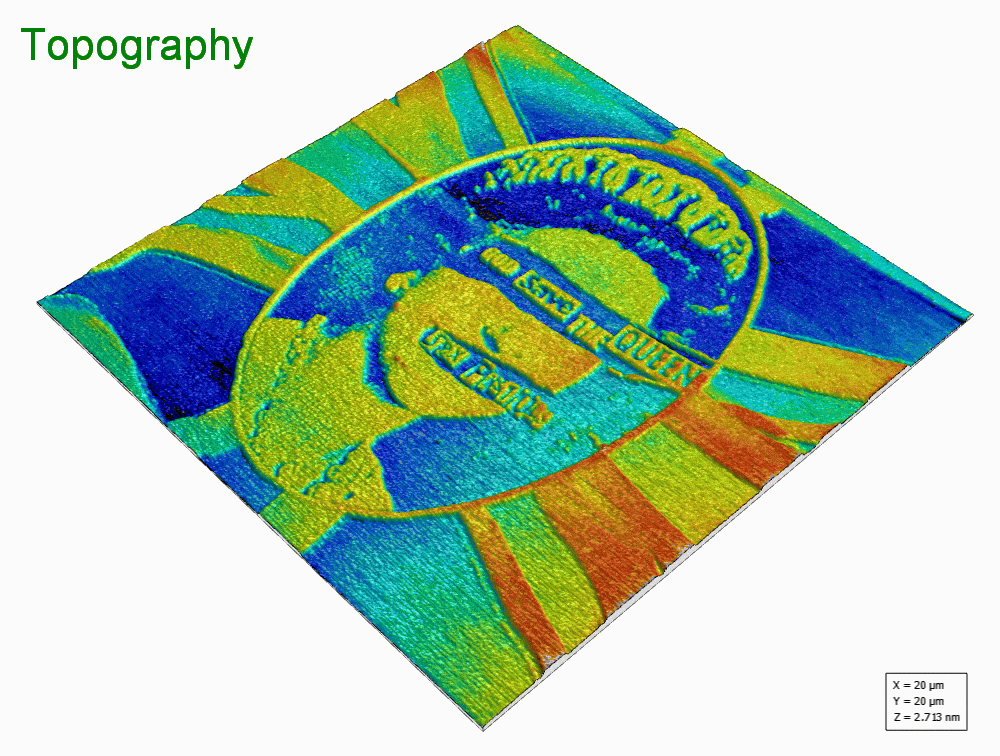30th June 2021 | Author: Iain Anderson
How working collaboratively can enrich your analysis
I’ve written before about how one of the benefits of my job is that I’m in an environment of constant learning, being surrounded by colleagues across our business who are experts in all manner of microscopy techniques. This week I dropped in, virtually, to one of our US demo facilities and ended up leaving with a (very basic) understanding of anodic oxidation lithography – a technique where we can use the tip of one of our AFMs to control the growth of silicon oxide on silicon.
Winding back time to the start of this little personal journey… what I first encountered were actually these EDS maps of the iconic cover from God Save the Queen by the Sex Pistols. Now for those of you that aren’t familiar with the song, which is around 200 seconds of classic punk.
The images piqued my interest as it’s not entirely normal to be running acquisitions on 20µm scale pieces of anarchic artwork, so I had to find out some more. The data here had been acquired on an electron microscope by one of our EDS applications specialists but the sample itself had been created by Ted Limpoco in the Asylum Research AFM lab next door.

God Save the Queen: Silicon (orange) and Oxygen (blue) element maps
The technique Ted used, called anodic oxidation lithography, starts with a silicon substrate, and then electrochemically forms a silicon oxide onto the surface. The sample needs to be maintained at a high humidity (~75% RH) in order to ensure that there is a constant and consistent layer of water on the sample surface with which the AFM tip can interact so it’s necessary to use a sealed chamber that allows for environmental control – he used the Cypher ES for this which can be configured to control heating/cooling as well as humidity. The silicon oxide growth is then provoked by applying a bias to the AFM tip at each map pixel. As well as being used to create nanoscale artwork, the technique has some potential as a method for fabrication of nanodevices.
In this case the growth of ~1nm of silicon oxide was demonstrated by moving the sample to an electron microscope and acquiring some quick EDS maps. Once we had collected data from both SEM-EDS and AFM, it was exported to our Relate correlative software. There are a lot of powerful tools in Relate that let us quantitively analyse the correlated datasets but this time it was more about art than science and we just wanted to present the most impactful visualisation of the data. The datasets were co-located, and the AFM topography used to render the sample surface which was then coloured in using the data layers from our EDS acquisition.

Acquired SEM-EDS and AFM maps correlated and visualised using our Relate software.
These little moments are things that give me a huge amount of satisfaction, and they are born from having our applications team working side by side with colleagues from Asylum Research. As our ‘family’ grows, so too do the opportunities to learn and that’s why I found it particularly exciting this week that Oxford Instruments has announced the acquisition of WITec GmbH. WITec has an impressive range of products including both standalone Raman microscopes and RISE – the world’s first fully-integrated Raman Imaging and Scanning Electron microscopes. I’m incredibly happy to welcome all our new colleagues and excited to find out how we can work together to offer better solutions to our customers – and of course to learn more cool stuff along the way too!
To learn more about any of the techniques mentioned in this post you can follow these links for the Cypher ES AFM and Relate software, or visit the WITec website and find out more about their product and techniques.






